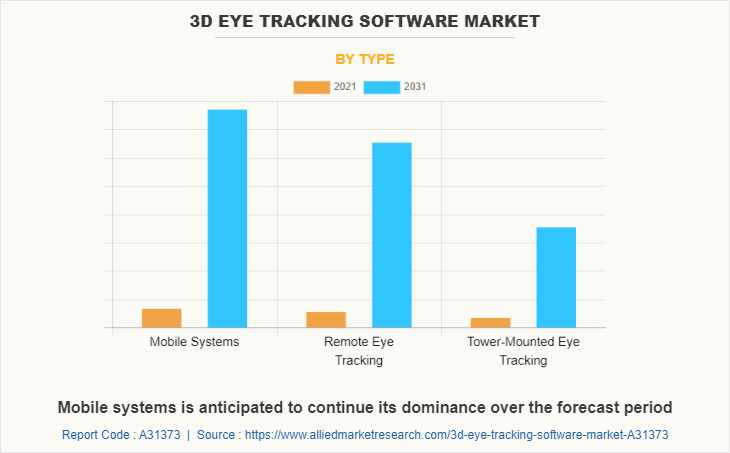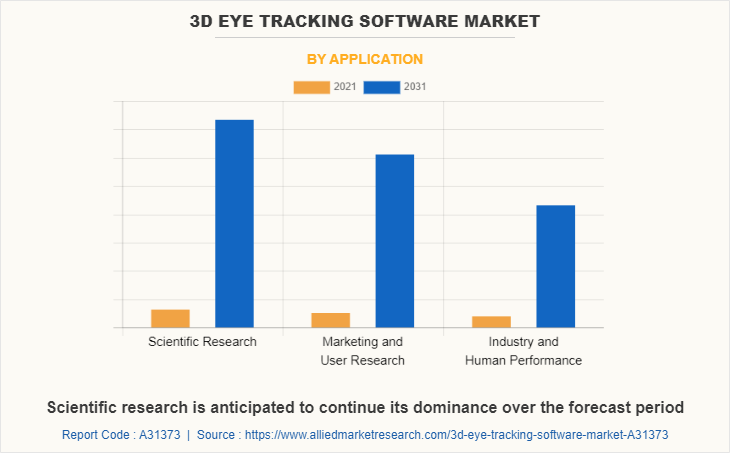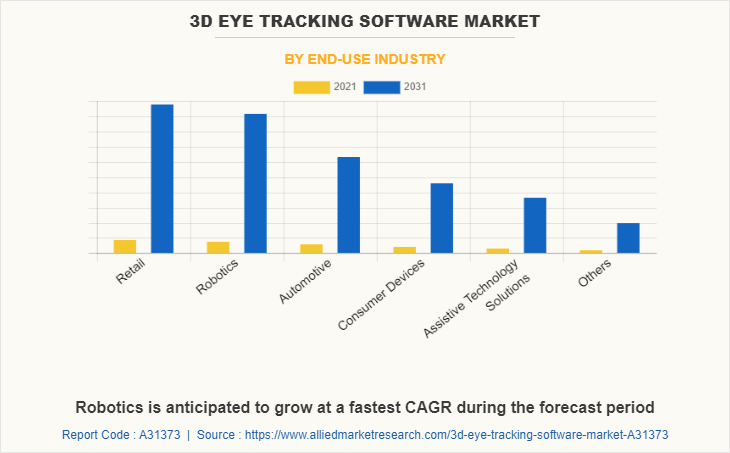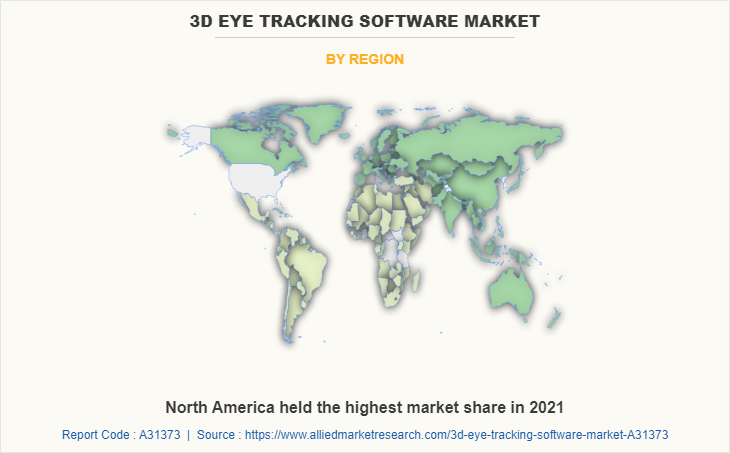3D Eye Tracking Software Market Research, 2031
The global 3d eye tracking software market was valued at $153.7 million in 2021, and is projected to reach $1.8 billion by 2031, growing at a CAGR of 27.8% from 2022 to 2031. 3D eye tracking software industry technology allows a computer or any other equipment to track data about the user's eye movement by detecting the presence, attention, and focus, as well as the position of the person's eye and pupil size, utilizing the eye’s reflection near the infrared light beam.
![]()
It delivers unique insights into human behavior and digitizes the way individuals interact with machines & devices by giving platforms for professionals to provide solutions.
The use of 3D eye tracking software to measure eye gaze offers new possibilities, and applications for human-machine interaction in the retail industry. Market researchers can monitor the attention of customers and retailers without fear of bias by employing 3D eye tracking technology. Eye tracking can be used to study the flow of interest, perception, and intention. When a product catches a shopper's interest, they proceed to evaluate it in a specific manner. Their view then determines whether or not they intend to purchase it. According to eye-tracking research, if initially the price appears, shoppers are more likely to see it as a better value. Retailers require visual cues along the route to make an informed purchasing decision. Retailers will be able to track visual attention in this process using 3D eye tracking software and see what better visual strategies and clues positioning work best for products.
Despite technological developments, 3D eye tracking software requires additional hardware & peripherals support to gauge the accurate results, which involves high cost of investments for the development and manufacturing of 3D eye tracking software devices. The retailers and small sized businesses find it difficult to invest in such technologies owing to shortage of funds, lack of awareness about these solutions, and technical support for the installation and use of 3D eye tracking software in their retail stores. These factors are responsible for limiting the market growth.
Over the past few years, eye trackers have become a crucial component of market research. These devices' data can often be used to improve how a company organizes its offline and online businesses. It is now possible to measure attention to specific brands, products, or key messages using advancements in 3D eye tracking software technology. It is also used to determine how easy or difficult it is to navigate a store. This is why attention tracking delivers critical data to businesses. 3D eye tracking software market outlook can provide shelf-attention analytics that count the number of views and focal points without the need for calibration. Retail and other marketing companies use these data to provide fresh sales strategies and shopper approaches to their retail clients.
The prominent players are investing massively in the R&D activities to develop technological advanced solutions to create strong business opportunity to sustain their presence in the global market. Apart from this, industry players are adopting various expansion strategies that include product launches, mergers & acquisitions, collaborations, and partnerships. These strategies enable manufacturers to expand their geographical presence in the global market. For instance, in January 2022, a leading global developer of semiconductor solutions, OMNIVISION partnered with eye-tracking technology company, Tobii to develop advanced solutions for vision in the Metaverse.
The key players profiled in this report include Eyeware Tech SA, Blink Technologies, Pupil Labs, SR Research Ltd., EYE SQUARE GMBH, EYETECH DIGITAL SYSTEMS, Gazepoint, Smarteye, Visage Technologies, and Tobii AB.
The 3D eye tracking software market is segmented on the basis of type, application, end-use industry, and region. By type, the market is divided into mobile systems, remote-eye tracking, and tower-mounted eye tracking. By application, the market is categorized into scientific research, marketing & user research, and industry & human performance. By end-use industry, the market is classified into retail, robotics, automotive, consumer devices, assistive technology solutions, and others. By region, the market is analyzed across North America, Europe, Asia-Pacific, and LAMEA.
The 3d eye tracking software market is segmented into Type, Application and End-use Industry.

By type, the mobile system segment dominated the market in 2021. Mobile eye tracking, also referred to as head-mounted eye tracking, uses a wearable device, most typically eye tracking glasses or a headband. In order to use this type of system, a camera or mirror that records the scene or user's field of vision must typically be put in front of one or both users' eyes. Modern mobile devices are untethered, enabling study in contexts that are considerably more relevant to everyday life, including sports, automobile & simulator use, motor-control & gait tests, and athletics. These are predicted to be the major factors fueling the 3D eye tracking software market size.

By application, the scientific research segment dominated the global 3D eye tracking software market share in 2021. It is possible to get important insight into development, learning patterns, and indicators of cognitive dysfunction or disease by examining visual behavior, such as those seen in individuals with Alzheimer's, Parkinson's, schizophrenia, autism, depression, and brain injury. 3D eye tracking software can be used to identify and study reading or learning disabilities such as dyslexia.

By end-use industry, the retail segment dominated the global 3D eye tracking software market share in 2021. 3D eye tracking software provides in-depth and unbiased data on customer behavior and thought processes. It enables brand owners and market analysts to examine the steps customers take to view and choose a product. It demonstrates to them which aspects naturally drew the most attention and which ones were disregarded. Eye tracking, which provides more accurate information than surveys or questionnaires, is important for creating advertisements, brands, packaging, and product placement.

By region, North America dominated the global 3D eye tracking software market in 2021. The dominance of this region can be attributed to rise in government spending in building technologically advanced tracking solutions. Further, rising penetration of electric vehicles wherein integration of 3D eye tracking software is rapidly surging to provide virtual driver assistance. This factor is likely to fuel the 3D eye tracking software market in the coming years. Moreover, rise in sales of robotics configured 3d eye tracking devices across various industries mainly automotive, metals & mining, and healthcare industry is fueling the global 3D eye tracking software market forecast period.
Impact of COVID-19 on the Global 3D Eye Tracking Software Industry
- COVID-19 has negatively impacted various industries such as automotive that has led to a drastic decline in automotive sales. As 3D eye tracking software is widely used in automotive, there was significant reduction in the 3D eye tracking software demand globally.
- The COVID-19 pandemic brought several uncertainties leading to severe economic losses as various businesses across the world were standstill. This lowered the demand for 3D eye tracking software due to lack of investment from major market players in 3D eye tracking technology.
- Sales of 3D eye tracking software is directly proportional to the demand from end-use industries namely automotive, retail, research, and others. However, the demand for 3D eye tracking software in retail industry was affected owing to import-export restrictions, closed borders, and supply chain disruptions due to the outbreak of the COVID-19 pandemic.
- The COVID-19 pandemic has slowed the rate of expansion of the eye tracking industry. Product demand was impacted by the shutdown of key consumer electronics, retail, automotive, and manufacturing industries.
Key Benefits For Stakeholders
- This report provides a quantitative analysis of the market segments, current trends, estimations, and dynamics of the 3d eye tracking software market analysis from 2021 to 2031 to identify the prevailing 3D Eye Tracking Software Market Opportunity.
- The market research is offered along with information related to key drivers, restraints, and opportunities.
- Porter's five forces analysis highlights the potency of buyers and suppliers to enable stakeholders make profit-oriented business decisions and strengthen their supplier-buyer network.
- In-depth analysis of the 3d eye tracking software market segmentation assists to determine the prevailing market opportunities.
- Major countries in each region are mapped according to their revenue contribution to the global market.
- Market player positioning facilitates benchmarking and provides a clear understanding of the present position of the market players.
- The report includes the analysis of the regional as well as global 3d eye tracking software market trends, key players, market segments, application areas, and 3d eye tracking software market growth strategies.
3D Eye Tracking Software Market Report Highlights
| Aspects | Details |
| Market Size By 2031 | USD 1.8 billion |
| Growth Rate | CAGR of 27.8% |
| Forecast period | 2021 - 2031 |
| Report Pages | 290 |
| By Type |
|
| By Application |
|
| By End-use Industry |
|
| By Region |
|
| Key Market Players | EyeTech Digital Systems, Pupil Labs, Gaze Intelligence, ParallelDots, Inc., Converus, IntelliGaze, Tobii Pro, iMotions, Gazepoint, Eyegaze |
Analyst Review
Rise in demand for 3D eye tracking software from retail industry is the key factor that is projected to drive the market growth. In addition, the use of 3D eye tracking software in automotive sector to capture the driver’s visual attention with respect to dashboard and navigation part is expected to fuel the market growth during the forecast period. 3D eye tracker tends to be expensive and many require additional hardware, such as glasses with connected cameras or customized headsets. Moreover, there is need for calibration before 3D eye-tracking software can provide accurate results. These factors are expected to hinder the market share of 3D eye tracking software. 3D eye tracking technology is introduced to human computer interaction and gaming to help game creators better understand gaming experiences, control them, and boost the realistic approach. Furthermore, assistive communicators, such as gaze interaction technology, which improve the lives of people with disabilities, are in high demand. This device is a computer access method that enables people with disabilities to navigate and control a computer by using only their eyes for all functions such as activating, selecting, and scrolling. . These factors are anticipated to provide remunerative opportunities for key players to invest in the 3D eye tracking software market in the upcoming years.
Among the analyzed regions, North America is expected to account for the highest revenue in the market by the end of 2031, followed by Asia-Pacific, Europe, and LAMEA.
The diverse applications of 3D eye tracking software across retail, automotive, medical, and research sectors are the major drivers for market growth. In addition, the use of 3D eye tracking software in marketing research to evaluate product, design, and to understand the shopping behavior of customers to develop marketing strategy is estimated to generate excellent opportunities in the 3D eye tracking software market.
The major growth strategies adopted by 3D eye tracking software market players are investment and agreement.
Retail sub-segment of the end-use industry acquired the maximum share of the global 3D eye tracking software market in 2021.
The report provides an extensive qualitative and quantitative analysis of the current trends and future estimations of the global 3D eye tracking software market from 2021 to 2031 to determine the prevailing opportunities.
Automotive industry leaders are the major customers in the global 3D eye tracking software market.
The use of 3D eye tracking software in academic & scientific research, usability research, PC & gaming industry, and in packaging research is estimated to drive the adoption of 3D eye tracking software.
Eyeware Tech SA, Blink Technologies, Pupil Labs, SR Research Ltd., EYE SQUARE GMBH, EYETECH DIGITAL SYSTEMS, Gazepoint, Smarteye, Visage Technologies, and Tobii AB are the major players in the 3D eye tracking software market.
Asia-Pacific is expected to provide more business opportunities for the global 3D eye tracking software market in the future.
Loading Table Of Content...



